Which is the best Woodheating solution for me?
The government have made it clear that they are phasing out oil and gas for house heating, to be replaced by heat pumps backed up by some form of sustainable, low carbon heating. Government grants are available to offset the initial cost of installing new systems.
- A Traditional Open Fire
- An Inset Log Burner
- Modular Inset stove
- Guillotene door models
- A Woodburning Stove
- A Woodburning Boiler Stove
- A Wood Pellet Stove
- Gas Stoves
- Masonry Chimneys
- Stainless Steel Insulated Twin Wall Chimney
Choosing your primary and secondary heating
A NEW BUILD project will be aiming for a house that is highly insulated and largely airtight. Depending on the size and heat demand that would normally either lend itself to a heat pump as primary heating backed up by a wood or wood pellet burning stove as secondary heating or, if the size and heat demand is higher, to the primary heating being wood pellet.
Into that mix you can add:
1) Solar PV panels - to offset the fact that your heat pump will be consuming a fair amount of electricity.
2) Solar thermal panels - to provide Domestic Hot Water (a heat pump's efficiency drops considerably when required to produce DHW temperature water)
Or
3) A back boiler in the wood or pellet stove to provide the DHW and, if needed, extra heating.
A RENOVATION project. If you are able to attain similarly high levels of insulation and airtightness throughout the house as a new build then you can treat it as above. It is often difficult or very expensive to achieve sufficiently high levels of insulation and airtightness in an existing building and then you should consider a wood pellet boiler system as your primary heating backed up by a wood burning stove. Into that mix you can add:
1) Solar PV panels - to offset the electricity you use.
2) Solar thermal panels - to provide Domestic Hot Water. Although the pellet boiler stove can easily provide the necessary DHW, a solar thermal panel allows you to take advantage of free energy when the sun is shining and saves your boiler firing up just to heat water. If the sun doesn't shine then the boiler will automatically take care of the DHW requirement.
If you have a good supply of free or cheap firewood then a further option is a log gasification boiler. A log gasification boiler burns wood at an efficiency of over 90% and has very low emissions. The wood is batch burnt at maximum efficiency with a thermal store holding the heat until it is needed. Unlike a wood pellet boiler it will need to be manually loaded and fired up every day or two and so, coupled with the wood preparation and storage, is comparatively labour intensive.
A combination of a log gasification boiler with a built in wood pellet burner gives a greater level of automation, giving you the choice of leaving it to the pellets or loading the boiler with wood.
The Boiler Upgrade Scheme is a government grant to help people make the transition to low carbon forms of heating like heat pumps or biomass boilers. It is an upfront payment of £5000 (or £6000 for ground source heat pump systems).
Burning Wood
Wood is a largely carbon neutral fuel, as it burns it simply re-releases the CO2 that it absorbed as the tree grew. As a new tree grows back in its place then that CO2 is captured again. This holds true whether it is burnt as logs or wood pellets. The high efficiencies demanded of a modern Ecodesign stove have resulted in the lowest ever level of emissions; reducing our personal carbon footprint as well as assisting in combating climate change.
Reducing Carbon output has become a global responsibility and creating a home which is designed with sustainable energy in mind is one way to help towards the zero emissions target. To encourage this, the government launched the Renewable Heat Incentive (RHI) back in 2014 with generous grants wood pellet and biomass boilers, as well as other forms of renewable energy, and this has now been replaced with the Boiler Upgrade Scheme grants. Having a woodburner as your secondary heating already improves your SAP rating.
A home quickly feels warm and cosy with the crackle and flame of a log fire on a cold winters evening,so it's not hard to see why a real wood fire, in all its different forms, remains an essential factor in so many dream homes.
A Traditional Open Fire
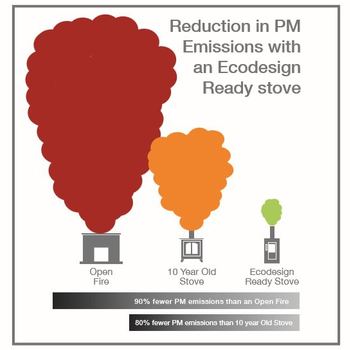
In a modern house or extension this is the least economical and most environmentally unsound option. All that time and money spent on insulation and air tightness goes out the window when you have an open chimney drawing out heat, even when the fire isn't lit. When the fire is burning it will suck large amounts of cold air into your house and the combustion in an open fire is both inefficient and results in very high particulate emissions. For all the look and feel of a traditional open fire, but without the detrimental effects on the building's airtightness, insulation and SAP rating, see here.
An Inset Log Burner
Woodburning insets come in two forms:
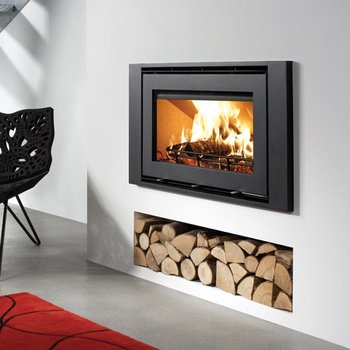
Side opening door models drawing convection air in below the firebox and putting out warm air above, like the Westfire 32 inset stove.
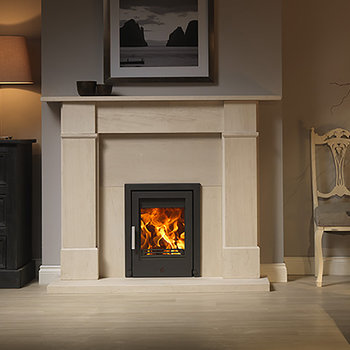
More like a traditional stove but set into the wall, like the ACR Tetbury inset.
Modular Inset stove
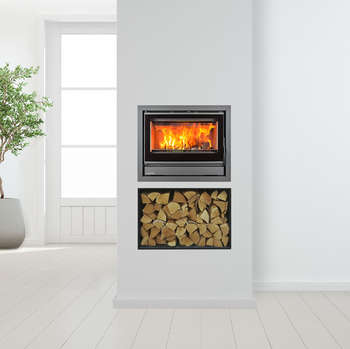
A straightforward and inexpensive way to build in the complete stove and chimney package is to spec a ready made modular stove and chimney like the Opus Scandfire. This gives you a pumice chimney breast, full height insulated chimney and a 5 kW insert woodburning stove.
The chimney breast and chimney arrive on site on two pallets and take a day to install. Once the plastering is completed in the house then the stove itself is delivered and takes an hour to fit. The whole installation is zero distance to combustibles so joists, skirting boards and roof timbers pose no issue and insulation and airtightness is not compromised.
Guillotene door models
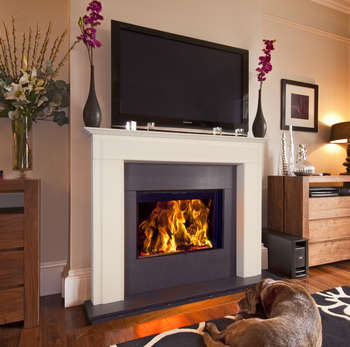
A guillotene door model can be set into a traditional fire surround or set higher up the wall for a more contemporary look. They have all the advantages of a stove - high efficiency, low emissions, airtight to the room, clean, controllable and safe and yet still give an uninterrupted view of the fire. With a dedicated air supply, they can even be used with the glass door up for those of us that, just occasionally, really need to experience a true open fire.
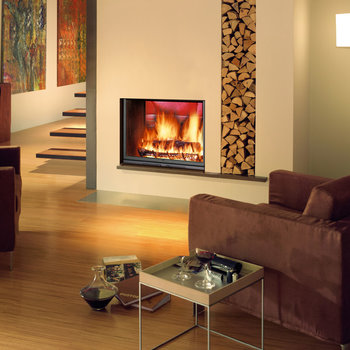
They are also available as double sided models like the stunning Fondis Stella III above.
A Woodburning Stove

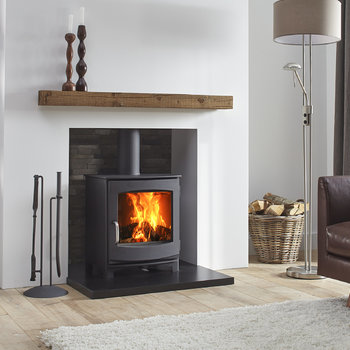
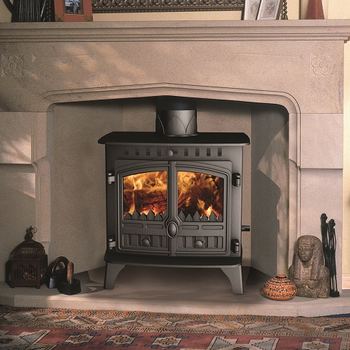
Woodburning stoves come in every shape, size and style from very traditional to ultra contemporary. Highly efficient, controllable, clean and safe, modern Ecodesign wood stoves burn extraordinarily cleanly and give a great focal point to any room.
They are the perfect secondary heating - there to keep you warm if your boiler or heat pump were to fail but also a pleasurable way to make any room cosy on a cold winters evening.
A Woodburning Boiler Stove
As well as providing some warmth to the room where it is installed, a boiler stove will also power the central heating and provide domestic hot water. It is a particularly good solution in conjunction with a conventional boiler as every time the stove is lit will mean that the gas or oil boiler switches off. If you have a good supply of wood it is also a very economical and environmentally friendly way to heat your home.
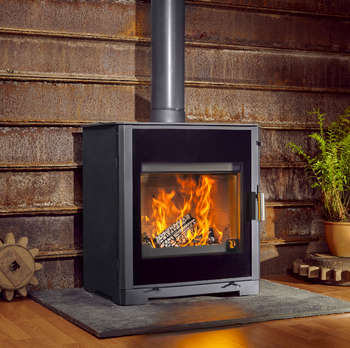
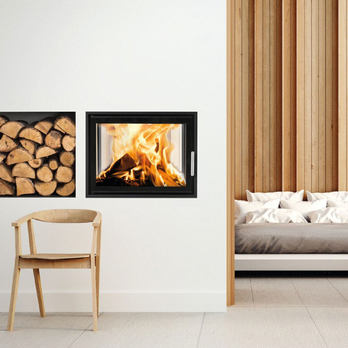
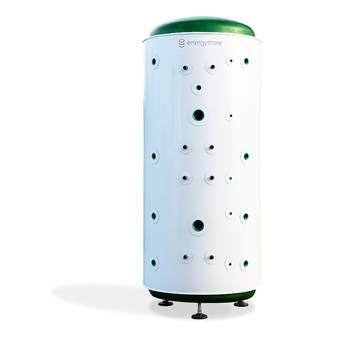
A boiler stove can be freestanding or an insert and can even come as a double sided insert stove.
Commonly a boiler stove feeds into a thermal store, which holds the heat until it is needed. This means that the stove is lit in the evening, heats the house and hot water and then gives the rest of its output to the thermal store. That heat is then used to warm the house next day until the stove is lit again in the evening. Thermal stores can be used to link solar thermal panels, gasification boilers, heat pumps, boiler stoves, etc.. providing domestic hot water and storing the heat until there is a heat demand from the house.
A Wood Pellet Stove
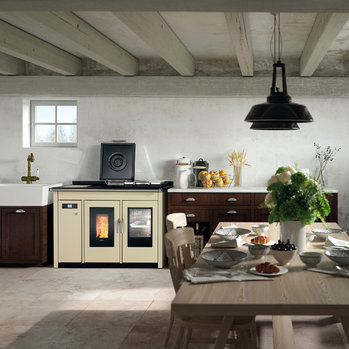
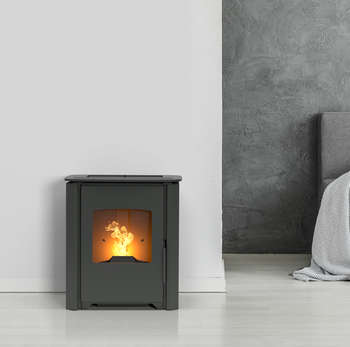
This is wood burning at its cleanest and most automated. A wood pellet stove can be programmed to turn itself on and off just like a conventional boiler and is self-feeding. It can be a simple room heater or a boiler model that does all the heating and hot water. Pellet stoves come in many forms - looking like a traditional woodburner, as a central heating cooker (like a 21st century Aga), as a utility model in the garage or an external model positioned outside.
Wood pellet boiler stoves are the best solution for heating existing properties where a heat pump would struggle to heat effectively during the cold season.
They are also eligible for the Boiler Upgrade Scheme grant of £5000, provided that the other eligibility criteria are met.
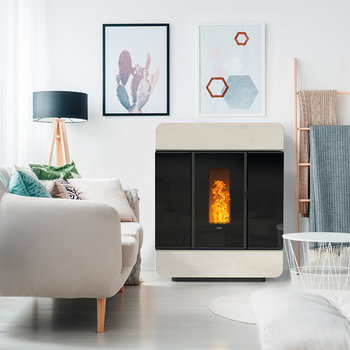
Masonry Chimneys
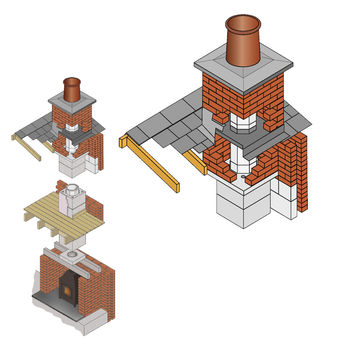
Chimney design has changed considerably since we've moved away from open fires and the days of red clay and concrete liners are over. An open fire wastes about 80% of its heat up the chimney while a stove will lose 20% or less. The result is that chimneys need to be well insulated to keep the flue gases warm, so avoiding dangerous tar condensation in the chimney as well as keeping the appliance working well. The normal material for a modern masonry chimney is pumice, which is both highly insulating and very stable.
Pumice chimneys are made either using the Double Module system, with an outer casing and an inner flue block, or with round pumice liners set into a leca backfill in a concrete block chimney. Both these systems can be zero distance to combustibles, making it straightforward as it passes through floors and the roof and enabling the building to easily retain its airtightness and high insulation value.
Stainless Steel Insulated Twin Wall Chimney
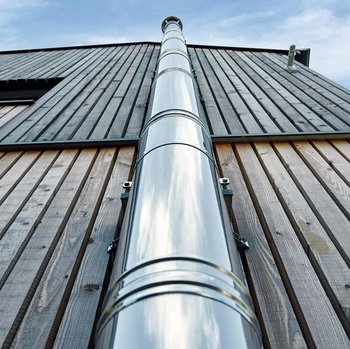
Quick to install, and taking the minimum amount of room as it passes through the house, twin wall chimney is often the simplest option to create a chimney. Consideration has to be given to ensuring that the chimney does not create a cold bridge where it passes through the roof or the wall as twin wall flue normally needs an air gap around it and requires at least 50mm to combustibles. Systems such as Schiedel's Ignis Protect allow the flue to make an airtight exit through a wall, even if it is made of combustible studwork. For a roof penetration Schiedel's 'Protect Box' achieves a similar result, ensuring that the insulation and airtight membrane remain continuous.


